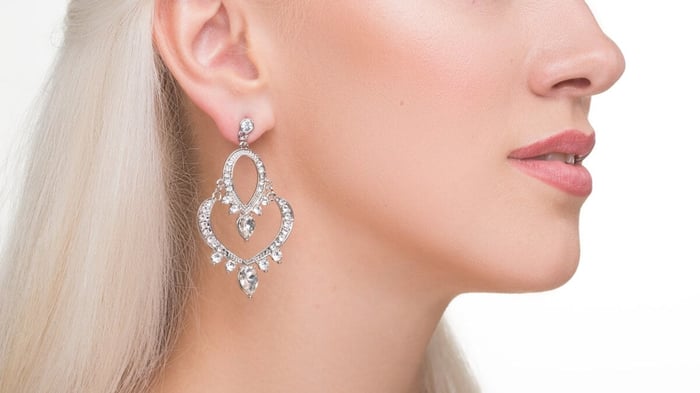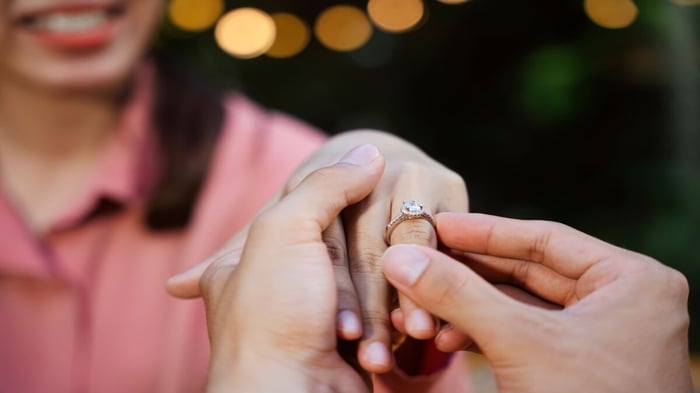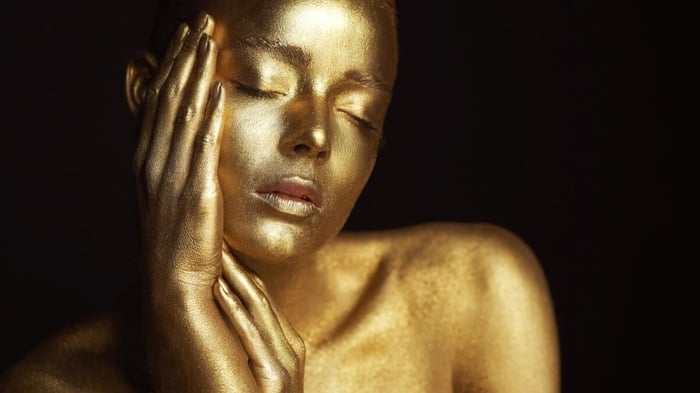Why Do Rhodium And White Gold Make A Perfect Jewellery Combination?
This article is about rhodium and white gold and the hidden secret that makes white gold so beautifully white.
White gold is the most popular choice for engagement rings; people love the pure white effect and the way it emphasises the diamonds’ brilliance on the ring. White gold works well for most diamond jewellery, whether a necklace, earrings or a bracelet.
White gold works well with all skin tones, whether it provides contrast or blends with the skin colour.
What Is White Gold?
Gold, in its natural state, is a soft, shiny yellow metal. Pure gold is too soft to be used in jewellery that will be expected to last for many years, especially in items such as rings. For this reason, pure 24 k gold is mixed with other metals in an alloying process. Most British jewellery has a gold purity of 18 or 9 karats meaning that it has 75% or 37.5% pure gold. The metals mixed into the gold vary slightly, but in the UK, yellow gold will have copper or silver added for durability.
White gold is a mixture of pure gold and palladium. In the United States, nickel is often used to create white gold, but that is illegal in the UK. Because nickel is less costly than palladium, US white gold tends to be less expensive than in the UK.
White gold is still slightly yellow, with a creamy warm tone, with 9k white gold being slightly warmer in tone.
The white gold we typically see in modern jewellery is a brilliant white colour resulting from a fine rhodium coating.
Claw Set Half Diamond Bangle 1.50ct G/SI Diamond in 18k White Gold

£2,918.00
£4,557.00
A real treasure for anyone who loves beautiful jewellery. The half diamond bangle is a popular choice that is sure to be a standout piece. 18k White Gold is a luxurious and classic choice for this jewellery. This high-quality piece… read more
What Is Rhodium?
Rhodium is the world’s most brilliantly white metal, making it an excellent choice for satisfying the modern desire for brilliance and sparkle. The colour of rhodium is very similar to the icy white fire of diamonds, making it difficult to tell the difference between white metal and diamonds. The effect is to enhance the visual display of diamonds with more sparkle and a larger apparent size.
When well polished, rhodium-plated white gold looks very similar to platinum but at a much lower cost.
Rhodium is a precious metal that is extremely hard to come by, which drives up its price. Rhodium is the most expensive precious metal there is, costing more than pure gold and even platinum. It is also the rarest precious metal. One of the reasons there isn't a large selection of jewellery made entirely of rhodium is its cost. Creating a piece of jewellery out of rhodium from start to finish is significantly more expensive than plating white gold with rhodium, which only requires a small amount of the precious metal. On the other hand, plating white gold with rhodium is a relatively inexpensive process.
The second reason, apart from the cost, is that while it looks beautiful, it is quite brittle. When it gets knocked in everyday use, gold tends to bend slightly. Often it is elastic enough to return to its original shape or, after a long period of use, may need to be reformed to its original shape. Rhodium, on the other hand, can crack and split.
As a coating on gold, rhodium has advantages apart from its colour and sheen. Its hardness gives a degree of scratch resistance that helps jewellery retain “as new” shine for longer than is the case with unplated white gold. Rhodium is also hypoallergenic, making it a good alternative for those who like silver but with skin sensitive to sterling silver.
Certified Shoulder Set Diamond Engagement Ring 0.90ct G/SI in 18k White Gold
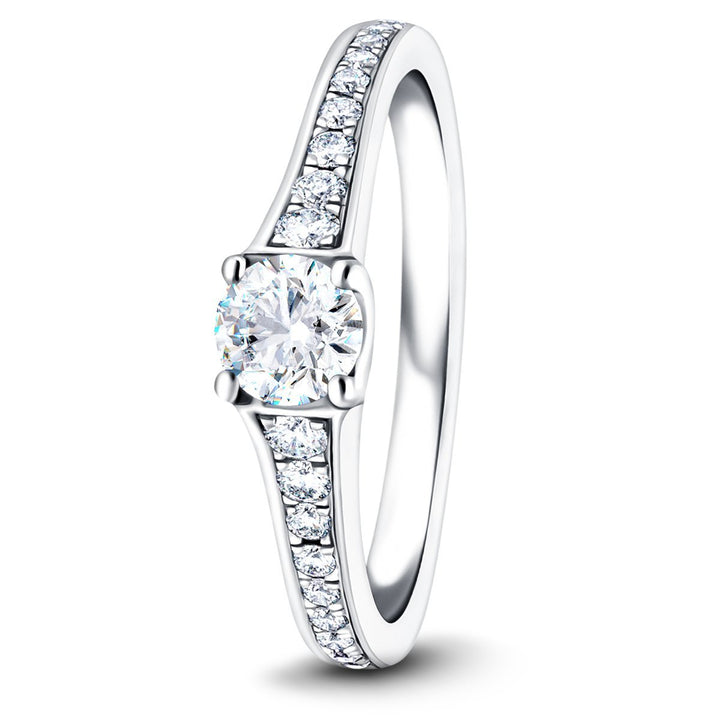
£2,838.00
£5,117.00
A luxury diamond engagement ring with a unique and stylish look. The ring is handcrafted with hand-selected natural diamonds, which are cut and polished in-house to ensure the highest quality. This custom-designed ring is made from fine 18K white gold. The… read more
How Is Rhodium Applied To White Gold?
Rhodium is applied to white gold using a process called electroplating. Electroplating works by placing rhodium into a solution. The jewellery item is placed into the solution, and an electric current is passed through the solution with the positive connection running to a platinised titanium anode. The current passes through the solution, picking up rhodium from the solution and depositing it to the negative anode, which is the jewellery being plated. The rhodium is deposited on the surface of the gold.
Apart from the setup time, the electroplating itself takes less than a minute to apply around one micron of rhodium over the entire gold surface.
Although rhodium is very expensive, the cost of replating is not high because such a small amount of metal is used to coat any jewellery item.
How To Care For Your Rhodium-Plated White Gold Jewellery
Although rhodium is very hard and scratch resistant, the rhodium coating will wear away over time. How long this will take depends very much on how often the item is worn and how much wear it gets. A ring will tend to need more frequent maintenance than a necklace.
When the rhodium wears away, the gold below becomes visible, giving the jewellery a light yellow appearance. The coating needs to be reapplied to restore the jewellery to its previous bright white condition. Many jewellers offer this service, and some can even provide it the same day or while you wait.
How Often Does Rhodium Need To Be Reapplied?
The frequency of wear and the type of metal the rhodium plating was applied to determine how long it lasts. Since rhodium plating deteriorates with use, it will disappear more quickly from frequently worn items like engagement and wedding rings. Additionally, because rhodium and white gold are similar in colour, rhodium plating generally has a longer lifespan on white gold jewellery. Minor wear and tear on rhodium plating is harder to notice on white gold. On the other hand, rhodium-plated items made of yellow gold or rose gold will show wear more quickly because these differently coloured metals are more easily seen through thinning rhodium.
You might expect to need a white gold engagement or wedding ring recoated every couple of years. A lightly worn necklace might never need to be replated.
We recommend that diamond rings be professionally cleaned and checked for loose stones every year or so. Recoating the rhodium can be done at the same time. Recoating is not very costly. Of course, the price will vary according to the jeweller doing the work. At today’s prices, you might expect to pay between £40-£250 depending upon the thickness of the coating, the amount of cleaning and polishing required and the design of the ring. Rings with absorbent gems such as pearls or opals will need to have these removed before replating. Gemstones do not conduct electricity, so they are unaffected by the plating process and do not need to be removed and reset.
A warning! Do not have your jewellery recoated before it is needed! Each time the ring is replated, the old rhodium must be removed, and any scratches must be polished out. This always removes a small amount of the underlying gold. Replating too often will lead to premature wear and weakness in the ring.
Aquamarine 3.97ct & 0.33ct G/SI Diamond Necklace in 18k White Gold
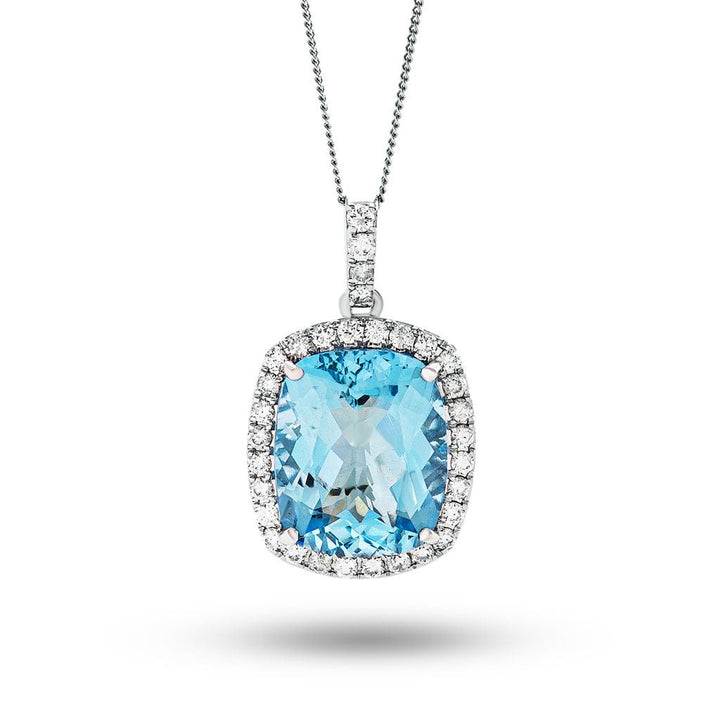
£2,848.00
£4,447.00
This necklace has almost four carats of striking aquamarine, hand-cut with care in the UK, framed with sparkling diamonds and suspended from a delicate chain of scintillating 18k white gold. An exceptional necklace that will bring attention at the fanciest… read more
All Diamond White Gold Jewellery
Now that you know all about rhodium and white gold, you can make an informed choice. Some people choose white gold over platinum because it is a less expensive purchase, which is a good choice. Even with the additional cost of occasional replating, white gold will retain its cost advantage for many years, especially if replating is done at the same time as routine maintenance, which is required for both platinum and white gold.
Remember that white gold will retain its polish better and for longer than platinum. White gold is also more rigid than platinum and is less likely to bend in everyday use. If the ring you choose has engraving on the band, then white gold is a better choice as the details will be retained as the ring is worn much better than possible with platinum.
Our British designers and artisans work with white gold and platinum every day, creating beautiful jewellery in both metals.
Please take a few minutes to browse our collections of white gold jewellery. You might be inspired for your next gift idea or the perfect engagement ring!
Princess Diamond Stud Earrings 2.00ct G/SI Quality in 18k White Gold

£9,788.00
£18,717.00
These gorgeous diamond earrings in 18k white gold feature a pair of princess cut diamonds with a four-prong corner setting to display and protect the diamonds that, in total, weigh 2.00CT. The natural diamonds are certified as G/SI quality and… read more
